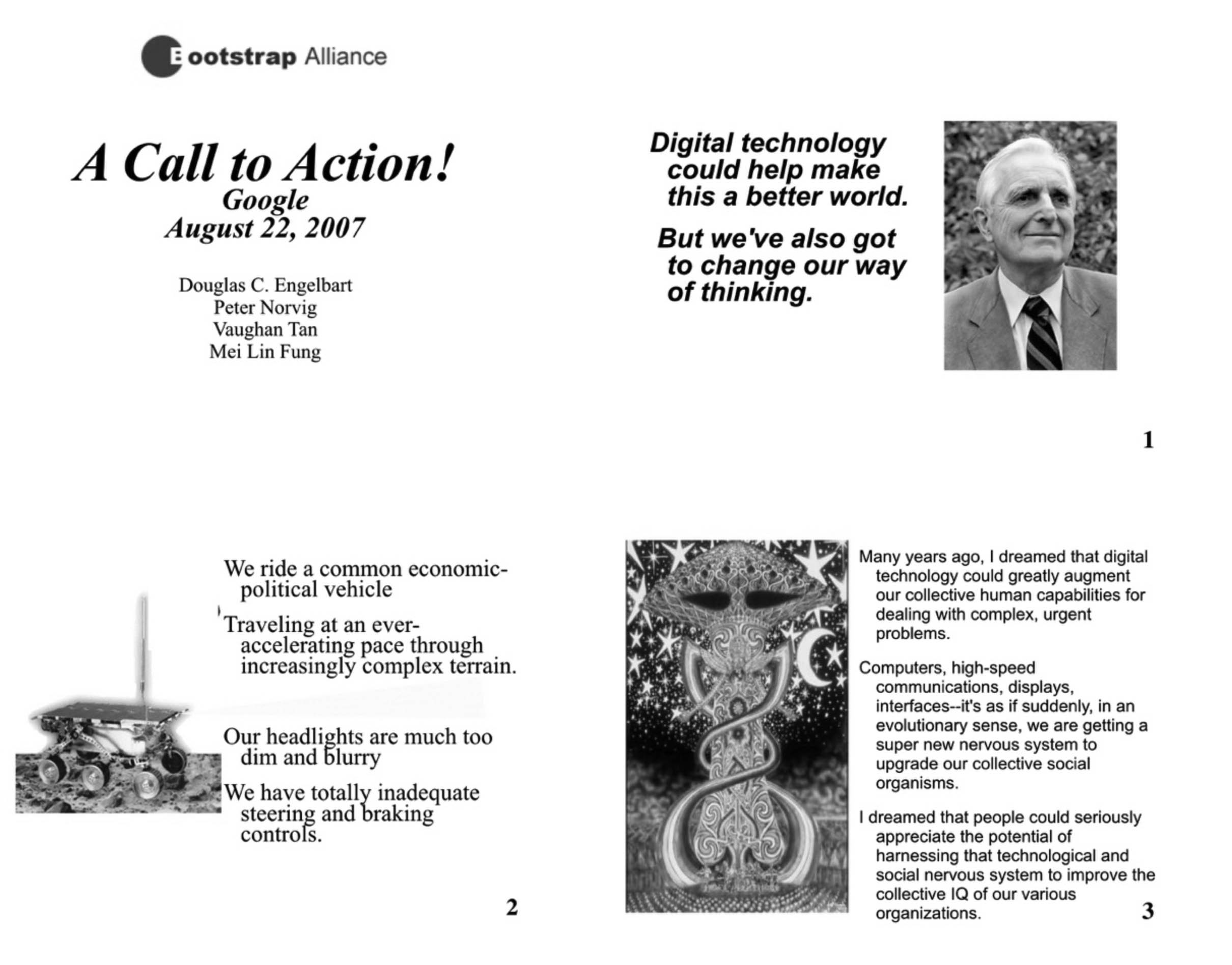STORIES
Contents
Federation through Stories
Pragmatics of an emerging paradigm
innovation for sustainability
We look at the emerging paradigm, as modeled by knowledge federation, from a pragmatic point of view. We have the global issues; and we have the information technology, and innovation in general. How can we inform their future course? We have already seen some of that, of course. But here we approach this most interesting theme by sharing the insights of giants who originated them. Two of them – and we begin our journey by telling their stories – are especially important for us, as progenitors and icons of the two core sides of our initiatives. Douglas Engelbart is introduced here as the icon of knowledge federation; Erich Jantsch is introduced as the icon of systemic innovation.
Vignettes
How to lift up an idea from undeserved anonymity
We tell vignettes – engaging, lively, catchy, sticky... real-life people and situation stories, to distill the core ideas of the most daring thinkers from the vocabulary of their field, and to give them the power of impact. We then show how to join the vignettes together into threads, and threads into patterns and patterns into a gestalt – an overarching view of our situation, which shows how the situation may (need to) be handled.
While it is the ideas that lead to the gestalt, it is the gestalt that gives the ideas their relevance, and their deeper reason for existence.
The incredible history of Doug
The 21st century printing press
Of course it's the Web – but...
The printing press is a suitable metaphor and a point of departure for us, because of its central role in the emergence of the last big societal paradigm shift. Indeed, Gutenberg's has often been credited for the spreading of knowledge that resulted in the Enlightenment, and all the other related transformations. What might play a similar role today? The story told next will highlight some of the main points in a palpable and vivid way.
His epiphany
Having decided, as a novice engineer in December of 1950, to direct his career so as to maximize its benefits to the mankind, Douglas Engelbart thought intensely for three months about the best way to do that. Then he had an epiphany.
On a convention of computer professionals in 1968 Engelbart and his SRI-based lab demonstrated the computer technology we are using today – computers linked together into a network, people interacting with computers via video terminals and a mouse and windows – and through them with one another.
In the 1990s it was finally understood, or in any case some people understood, that it was not Steve Jobs and Bill Gates who invented the technology, or even the XEROS PARC from which they took it. Engelbart received all imaginable honors that an inventor can receive. Yet he made it clear, and everyone around him knew, that he felt celebrated for a wrong reason. And that the gist of his vision had not yet been understood, or put to use. "Engelbart's unfinished revolution" was coined as the theme for the 1998 Stanford University celebration of his Demo. And it stuck.
The man whose ideas created "the revolution in the Valley" passed away in 2013 – feeling that he had failed.
Engelbart's unfinished revolution
What did Engelbart see in his vision, and pursued so passionately throughout his long career? Why was this vision not understood?
It seems best to introduce it by another anecdote, and – if not by his own words, then at least by his own Powerpoint slides. Here they are.

Around that time Engelbart was diagnosed as having Alsheimer's disease, and it was clear hat his career was coming to an end. The title he choose for his presentation should make it clear that what he wanted to give to Google, and to the world, was a direction call to pursue it.
The first slide makes it clear that a large and unfulfilled opportunity has remained in digital technology. To realize it, we must change the way we think.
The second slide specifies what exactly that new thinking might be. The message is so closely similar to the message of our Modernity ideogram (see Federation through Images), that we only need to point to our explanation there. But there is also a word for this way of thinking; and the word is "systemic".
The third slide then is his, and our, main point. Why is this new way of thinking necessary if the digital technology should give us the benefits that it has in store for us?
The slide has three </div> </div>

